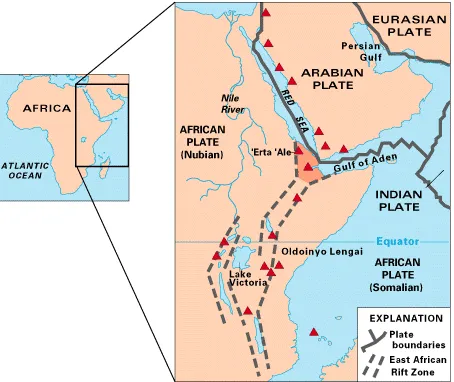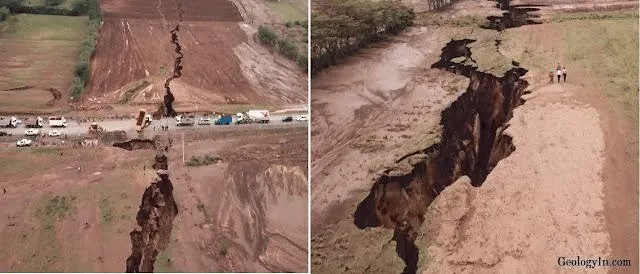During our early school years, we are taught that the Earth’s continents were once merged together to form a single continent called Pangea, which eventually separated over millions of years. Now, further research has revealed the formation of Africa’s new ocean, indicating that such geological transformations are ongoing.
Scientists predict that even in the distant future, after our species has ceased to exist, the Earth will continue to experience similar geological events, including the division of landmasses. In fact, it is believed that there will be at least one more such division in the future.
According to recently published research in the peer-reviewed journal Geophysical Research Letters, Africa is currently undergoing a process of rifting, causing it to split into two major sections. This phenomenon could eventually lead to the creation of a new ocean.
The research sheds light on the reasons behind this splitting process and the potential timeline for Africa’s breakup.

The enormous splitting of Africa is linked to the East African Rift System (EARS), one of the world’s largest rifts that extends for thousands of kilometers through multiple African countries.
Reports of a crack forming in Kenya in 2018 went viral, with many claiming it was evidence of Africa breaking apart before our eyes.
What is rifting?
Rifting is a geological process by which the Earth’s crust and lithosphere are stretched and pulled apart, resulting in the formation of a rift valley or a rift zone.
It usually occurs along the boundaries of tectonic plates and is characterized by a series of faulting, earthquakes, and volcanic activity.
In the case of the African continent, the rifting process has resulted in the formation of the East African Rift System, which stretches over several countries and is causing the continent to split into two plates – the Somalian and Nubian plates.
Over millions of years, this process of rifting will eventually result in the formation of a new ocean between the two plates.
Why is Africa is splitting into two?
Africa is splitting into two because of the East African Rift System (EARS), which is a massive geological fault that runs from Ethiopia to Mozambique. This rift is caused by the movement of tectonic plates beneath the Earth’s surface.
The East African Rift Valley, which extends for over 3,000km from the Gulf of Aden in the north to Zimbabwe in the south, divides the African plate into two plates – the Somali and Nubian plates, according to The Conversation.

This unique location provides scientists with the opportunity to study the transformation of a continental rift into an oceanic rift, as stated by Christopher Moore, a doctoral student at the University of Leeds, in Mashable.
During the process of rifting, material from deep within the Earth rises to the surface and forms oceanic crust at the ridges, as reported by NBC News.
The African continent sits on the African Plate, which is slowly pulling apart along the EARS. This process of separation has been occurring for around 25 million years, and it is causing the African Plate to divide into two separate plates – the smaller Somalian Plate and the larger Nubian Plate.
As these plates move away from each other, they create a gap or a rift in the Earth’s crust, which will eventually become a new ocean. This process is slow, and it is happening at a rate of a few millimeters per year.
How long before Africa is divided?
According to a 2004 study, the East African Rift System, which is causing the African continent to split into two plates – the Somalian and Nubian plates, is moving at a very slow pace of a few millimeters per year.
While it is difficult to predict an exact timeline for the complete separation of the African continent, scientists estimate that it may take another 5 million to 10 million years for a new ocean to form between the two plates, as reported by a recent article in The Conversation.
It is important to note that this process of continental rifting is a slow and gradual one, occurring over a geological timescale that is much longer than human history.
Splitting of Africa will redefine Indian Ocean
The splitting of the African Plate into the Somali and Nubian plates is likely to redefine the geography of the African continent and the Indian Ocean in the future.
The separation of these plates will eventually result in the formation of a new ocean basin, which will likely change the coastline and topography of East Africa.
It will also create new opportunities for the exploration and exploitation of marine resources in the region.
FAQ:
What is the total land area of Africa?
30,365,000 km2
How many countries are present in Africa?
54
Keep Reading
- How retreat of Machoi glacier impacting lives in Kashmir?
- “Give Plastic, Take Gold” Initiative In Sadiwara Village Of Kashmir
- India’s Clean Tech Can Achieve Energy Independence By 2047: Study
Follow Ground Report for Climate Change and Under-Reported issues in India. Connect with us on Facebook, Twitter, Koo App, Instagram, Whatsapp and YouTube. Write us on GReport2018@gmail.com.






